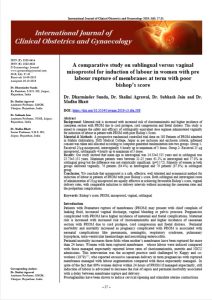
Background
Maternal risk is increased with increased risk of chorioamnionitis and higher incidence of caesarean section with PROM due to cord prolapse, cord compression and foetal distress. This study is aimed to compare the safety and efficacy of sublingually equivalent dose regimen administered vaginally for induction of labour in patient with PROM with poor Bishop’s Score.
Material & Methods
A prospective randomised controlled trial done on 180 Patients of PROM admitted in Mahila chikitsalaya, SMS Medical College, Jaipur as per inclusion and exclusion criteria, informed consent was taken and allocated according to computer generated randomization into two groups. Group 1- Received 25µg misoprostol, intravaginally 4 hourly up to maximum of 3 doses. Group 2- Received 25 µg misoprostol, sublingually 4 hourly up to maximum of 3 doses.
Results
Our study showed that mean age in intravaginal was 24.33±3.535 years and in sublingual was 23.73±3.151 years. Maximum patients were between 21-25 years 61.1% in intravaginal and 57.8% in sublingual group but the difference was not statistically significant. (p=0.172). Majority of women in both groups delivered vaginally; 76 patients (84.4%) in intravaginal and 79 patients (87.8%) in sublingual group.
Conclusion
We conclude that misoprostol is a safe, effective, well tolerated and economical method for induction of labour in patients of PROM with poor Bishop’s score. Both sublingual and intravaginal route of administration of 25µg misoprostol are equally effective in achieving favourable Bishop’s score, vaginal delivery rates, with comparable induction to delivery intervals without increasing the caesarean rates and the postpartum complications.